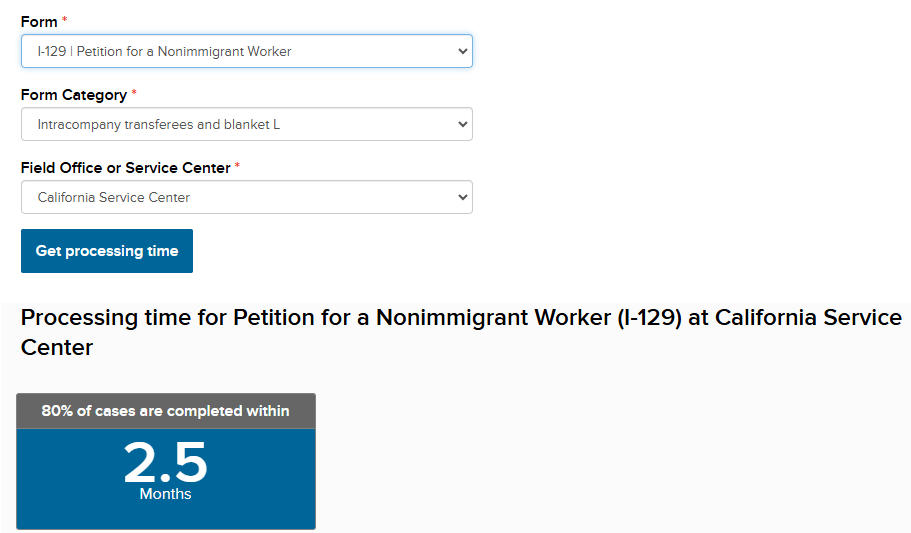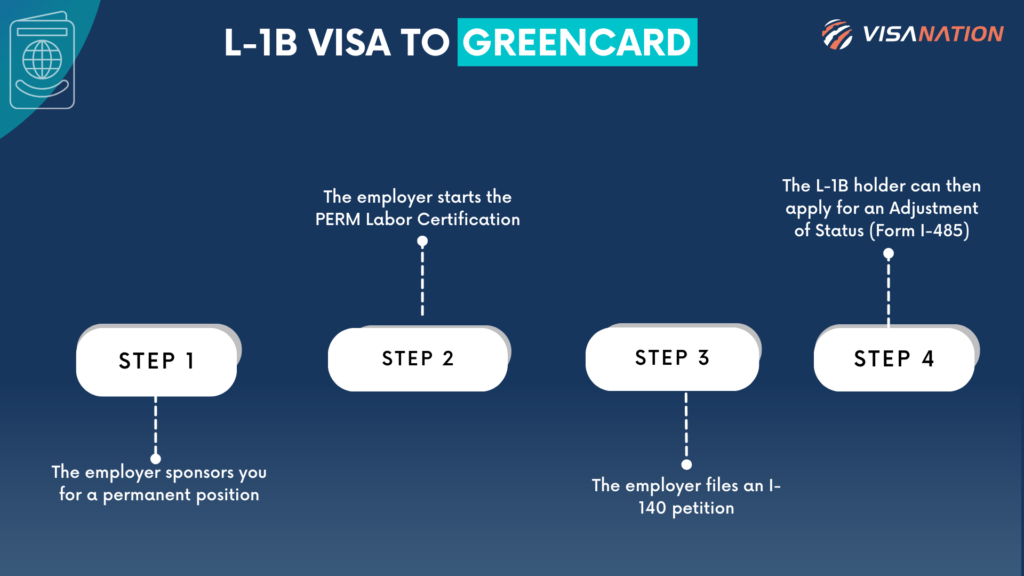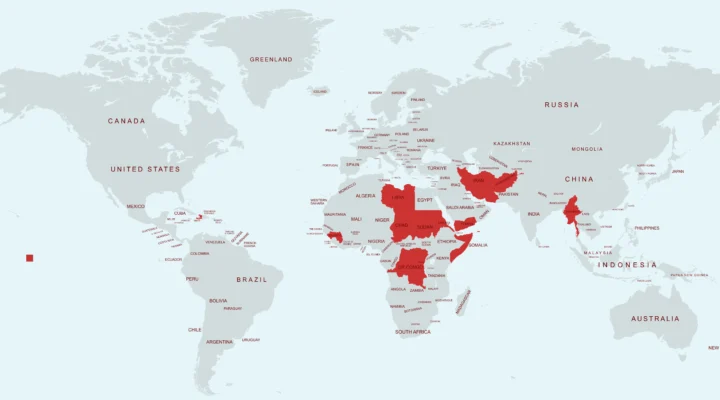Under the L-1 visa, also known as the intra-company transfer visa for specialized workers, there are two separate classifications, the L-1A and the L-1B visa. This guide highlights the L-1B visa, which was developed to help companies bring in foreign employees whose unique skills are critical to the organization’s operations in the U.S.
In this guide, you will learn everything else you will need to succeed, including:
- What is “Specialized Knowledge”
- Eligibility and requirements
- Visa costs
- Processing times
- Required documents
- Dependent visas – bringing your family along
- Transitioning to a green card
- H-1B or L-1B
What is an L-1B Visa?
The L-1B visa is fundamental for multinational companies seeking to relocate key talent with “specialized knowledge” to the United States from their offices abroad. This visa not only allows for the transfer of employees to existing U.S. offices but also enables foreign companies to send specialized workers to help launch new offices in the United States.
Unlike other employment-based visas, the L-1B does not require a specific academic degree, focusing instead on the professional’s specialized skills and company-specific knowledge.
Here’s what makes the L-1B Visa stand out:
- Talent Mobility: Enables companies to transfer specialized employees from foreign offices to the U.S.
- Business Expansion Support: Ideal for both existing U.S. branches and launching new operations.
- Flexible Eligibility Criteria: Prioritizes professional expertise over formal educational qualifications.
- Dual Intent Benefits: Allows holders to pursue permanent residency without jeopardizing their visa status.
- Avoid the Lottery: Unlike the H-1B, there’s no cap on visas, providing consistent opportunities for transfers.
What is Specialized Knowledge?
Now that you know the basics, let’s explore the concept of specialized knowledge as it relates to the L-1B visa.
Specialized knowledge means a worker has skills or expertise that are vital to a company’s work.
For the L-1B visa, this may include specialized knowledge of:
- Products – requiring specialized knowledge to design, manufacture, or enhance products to meet specific market needs.
- Services – intangible offerings that rely on specialized knowledge to deliver, tailor, or solve complex problems effectively.
- Research – investigation to discover new knowledge or innovations, requiring specialized knowledge to drive breakthroughs in the organization’s field.
- Equipment – tools or machinery used by an organization, needing specialized knowledge to operate, maintain, or innovate.
- Techniques – specific methods or skills to solve problems or produce results, where specialized knowledge is key to their effective application.
- Management practices – strategies and approaches for organizing resources, where specialized knowledge ensures efficient decision-making and long-term success.
- Processes and procedures – established workflows to maintain quality and consistency, requiring specialized knowledge to develop or refine.
- Application of knowledge in international markets – use of specialized knowledge to adapt or expand the organization’s products, services, or strategies to succeed in global or foreign markets.
How does this apply in real life? Here are some examples:
Specialized knowledge example A:
Maria, a software engineer with expertise in artificial intelligence (AI), works for a tech company that develops cutting-edge AI-driven medical diagnostic tools. Her specialized knowledge includes an in-depth understanding of machine learning algorithms tailored for healthcare applications, which is crucial for creating accurate diagnostic models. Maria’s expertise is not only rare but essential to the company’s success in the global medical technology market. As a member of the engineering profession, she holds an advanced degree and has years of experience, making her a specialized knowledge professional. Her role is vital to the company’s ability to expand into international markets, where her expertise in AI for medical applications sets them apart from competitors.
Specialized knowledge example B:
John is a software developer with specialized knowledge in cloud computing and cybersecurity, specifically for financial services. He has worked on developing secure platforms that meet international regulatory standards for banks. His expertise is critical to his company’s expansion into global markets, where financial institutions require high levels of security and compliance. John’s ability to design secure, scalable systems that comply with regional laws makes him a specialized knowledge professional, and his skills are essential for the company’s international growth, qualifying hi for an L1B visa.
Eligibility and Requirements
To qualify for an L-1B visa, both the U.S.-based employer and the employee must meet specific criteria. These requirements ensure that the employee’s specialized knowledge is essential for the company’s U.S. operations.
For the U.S. Employer:
- Qualifying relationship between the foreign and U.S. company showing a clear connection between the foreign company and the U.S. office (parent company, branch, subsidiary, or affiliate).
- Currently or plan on conducting business in the U.S. and at least one other country.
- Demonstrate a concrete plan to support the employee’s role, outlining their responsibilities and contributions.
- Have the financial ability to compensate the employee and support their position.
- There must be a dedicated work location for the employee in the U.S.
For the employee:
- The employee must have been employed by the foreign company for one continuous year (full-time) within three years before filing the L-1B petition.
- Have worked for a foreign company outside of the U.S.
- Only work in the U.S. for the same company that is petitioning them.
- Be able to provide specialized knowledge.
- Be intend to leave the U.S. once their visa status expires.
Compared to other visa categories, an L-1B visa does not require a degree to qualify. Holders of this visa can also bring along their spouses and children who are unmarried and under 21 years old through the L-2 visa. Spouses are eligible to work if they qualify for an employment-authorized document or have an unexpired I-94 form with a notation indicating the L-2 nonimmigrant status.
How long is the L-1B visa valid?
The duration of the L-1B Visa is between one to three years, dependent on whether the office is established or new:
- For established offices: The L-1B visa is granted for an initial period of three years for employees transferring to the U.S. office of a company with established business operations. This means that if the employee is being transferred to a U.S. office that is already functioning (i.e., the company has been doing business in the U.S. for some time), the employee is eligible for a three-year stay initially.
- For new offices: If the employee is coming to the U.S. to establish a new office, the initial stay is limited to one year. This is because the U.S. office is still in the process of setting up and doesn’t yet have a fully established operation. The employee’s role is critical during this phase, as they are likely helping to build the infrastructure and operational processes of the new office.
How to Extend the L-1B visa:
For both new offices and established offices, employers can stay for a maximum time of five years with extensions:
- For established offices: Employees who have been granted an initial three-year stay can apply for an extension in increments of up to two years. This allows the employee to extend their stay for a maximum total of five years. To qualify for an extension, the employer must demonstrate that the employee’s specialized knowledge remains crucial to the organization’s U.S. operations.
- For new offices: For employees sent to establish a new office, after the initial one-year stay, they can extend their stay in increments of two years as well, reaching the same five-year maximum. The five-year cap still applies, meaning that after 5 years, the employee must leave the U.S. unless they change status (for example, to an H-1B or another work visa, if eligible).
How much does the L-1B Visa Cost?
|
Fee |
Amount |
Conditions |
Responsible party |
|
Form I-129 filing fee |
$1,385 |
Applies to all L-1B applicants. |
Employer |
|
Form DS-160 filing fee |
$205 |
Applies to all L-1B applicants. |
Employer |
|
Fraud Prevention and Detection Fee |
$500 |
Only applies to initial petitions for L-1B status. |
Employer |
|
Asylum Program Fee |
$600: Large Companies |
Based on employer size. Nonprofits are exempt. |
Employer |
|
Public Law 114-113 Fee |
$4,500 |
Applies to employers with more than 50 employees, with more than 50% of those employees in L-1, H-1, or L-2 status. |
Employer |
|
Premium Processing Fee (Optional) |
$2,805 |
Optional |
Employer or Employee (depending on agreement) |
|
Attorney’s Fees |
Varies |
Dependent on the attorney and complexity of the case. |
Employer |
|
Biometric Services and Interview |
Varies |
Depending on the consulate/embassy, an biometric and/or interview fee may apply. |
Employee (Applicant) |
Total L-1B Fees (Excluding Attorney Fees)
For a Small Company:
- Form I-129 Filing Fee: $695
- Form DS-160 Filing Fee: $205
- Fraud Prevention and Detection Fee: $500
- Asylum Program Fee: $300
- Public Law 114-113 Fee: $0 (Not applicable for small companies)
- Premium Processing Fee: $2,805 (optional)
Total (Excluding Premium Processing): $1,700
Total (Including Premium Processing): $4,505
For a Large Company:
- Form I-129 Filing Fee: $1,385
- Form DS-160 Filing Fee: $205
- Fraud Prevention and Detection Fee: $500
- Asylum Program Fee: $600
- Public Law 114-113 Fee: $4,500 (Applies to large companies with 50+ employees and more than 50% of employees in L-1, H-1B, or L-2 status)
- Premium Processing Fee: $2,805 (optional)
Total (Excluding Premium Processing): $7,190
Total (Including Premium Processing): $9,995
Processing Times
The processing time for an L-1B visa involves:
I-129 filing (Petition for a Nonimmigrant Worker): 3.8 months according to USCIS processing times.
-
- This can vary depending on the service center processing the form.
- Premium processing reduces this time to 15 business days after receipt of request.
- Up-to-date estimates can be found on the USCSIS processing times page by selecting I-29, then selecting “intracompany transfers, and lastly choosing a service center.

Consular processing: For applicants applying from outside the United States, you must submit a DS-160 form and attend an interview at the consulate in their home country. This process is called consular processing and can take from a few weeks to two months depending on the consulate
Applicants applying within the U.S.
Applicants with an approved L-1B visa in the U.S. can apply for an adjustment of status to remain.
Documents for L-1B Visa
Below, you will find all the necessary supporting documents that are needed to apply for an L-1B visa:
Personal and Identification Documents
- Valid passport (with at least six months left)
- Two recent color photographs meeting U.S. criteria
- DS-160 visa application confirmation page
- Copy of Form DS-160 and L supplement
Employer Documents
- Copy of the I-129 petition submitted to USCIS
- I-797 approval notice from USCIS
- Detailed proposed job duties and description (with foreign employer and U.S. company)
- Employment verification letter from the foreign company
- Organizational charts
- Letter of reference from supervisors/colleagues
- Tax returns
- Company certificates of training undertaken
Professional Documents
- Resume/CV
- Education certificates (e.g., university degree)
- Pay stubs
- Projects employee has worked on
- Statements explaining the specialized knowledge of the employee
Bringing dependents on an L-1B Visa
The following details the rights of family members of L-1B visa holders to live, work, and study in the United States as a dependent.
Can the spouse of an L-1B visa holder work in the USA?
Yes, spouses of L-1B visa holders can live and work in the United States through the L-2 visa, which is designated for spouses and unmarried children (under 21 years old) of L-1 visa holders. It allows family members to legally reside in the U.S. while the primary L-1B visa holder works.
Key Features of the L-2 Visa:
- Work Authorization: Spouses of L-1B visa holders are automatically authorized to work in the U.S. without needing to apply separately for an Employment Authorization Document (EAD). They can work full-time, part-time, or even start their own business.
- Children with an L-2 visa are not eligible to work in the United States.
- Study: Both spouses and children on L-2 visas can enroll in academic courses or full-time degree programs without needing a separate student visa.
- Validity: The L-2 visa’s validity is directly tied to the L-1B visa holder’s status. If the L-1B visa is extended, the L-2 visa can be extended accordingly.
- Travel: L-2 visa holders can travel freely in and out of the U.S. as long as their visa remains valid.
L-1B Rules for New Offices vs. Established Offices
- Established Office:
- An established office is a business that is already operating in the U.S. when the employee applies for an L-1B visa.
- The employer must prove that the business has an ongoing presence in the U.S. by providing evidence such as lease agreements, utility bills, payroll, or tax records.
- The employee does not need to be responsible for setting up the office, as it is already operational.
- New Office:
- If the office is considered “new,” meaning it’s in the early stages of expansion, the employee may be expected to help set up the office in the U.S.
- This could include tasks like securing a location, hiring employees, and starting business operations.
- The employee would initially be granted a one-year stay to help establish the office.
- After one year, the employer would need to prove that the business has grown and is operating more substantially.
Employers and visa applicants must understand these requirements applicable to their situation to ensure a successful visa application process.
Can an L-1B Visa Holder Apply for a Green Card?
Yes, an L-1B visa holder can apply for a Green Card (permanent residency) in the U.S., but the process typically requires transitioning from the L-1B visa to an employment-based green card.
Here’s how it works:
- Employer Sponsorship: L-1B holders apply for a Green Card through employment-based immigration. Their employer must sponsor them for a permanent position that requires their specialized knowledge.
- Transition to an available green card, such as:
- The L-1B visa holder has their employer start the PERM process, including completing a labor certification. This proves that there are no qualified U.S. workers available for the position.
- The employer files an I-140 petition which classifies the applicant as an Immigrant Worker.
- After the I-14o is approved, the L-1B holder can then apply for an Adjustment of Status (Form I-485) to become a permanent resident while staying in the U.S.

Why Choose an L-1B Over an H-1B visa?
Both the L-1B and H-1B visas cater to foreign workers with specialized knowledge, but they differ in purpose, eligibility, and flexibility within the U.S. immigration system. Understanding the key distinctions can help you choose the right visa based on your circumstances. Find out more about L-1 visa vs H-1B visa comparison.
Example: A software development company based in India wishes to relocate one of its experienced developers to its U.S. subsidiary. In this case, the L-1B visa would be the appropriate choice to facilitate the transfer of this employee to the U.S. office. Conversely, if a pharmaceutical company in Canada intends to hire a research scientist for a specialized project in its U.S. research facility, the H-1B visa would be more suitable for sponsoring this individual directly from Canada to work in the U.S.
Education Requirements
- L-1B Visa: This visa is designed for intra-company transferees with specialized knowledge who are being transferred from a foreign branch, subsidiary, or affiliate of a multinational company to a U.S. office.
- H-1B Visa: This visa allows U.S. companies to hire foreign workers directly for specialized positions within their organization, whether the employee is coming from abroad or already in the U.S.
Annual Cap
- L-1B Visa: The L-1B visa program does not have an annual limit, offering greater flexibility for multinational companies to transfer their employees as needed without facing visa quota constraints.
- H-1B Visa: The H-1B visa program imposes an annual cap or limit on the number of visas issued each fiscal year, subject to a lottery system due to high demand.
Prevailing Wage
- L-1B Visa: There are no prevailing wage requirements for L-1B visa holders, giving employers greater flexibility in determining compensation.
- H-1B Visa: Employers sponsoring H-1B visa holders are required to pay a prevailing wage, ensuring that foreign employees receive compensation comparable to their U.S. counterparts in similar positions.
However, employers have more flexibility in adjusting wages for employees on L-1B visas, as they are not bound by prevailing wage requirements.
Duration of Stay
- L-1B: The L-1B visa provides an initial stay of up to 5 years, which is slightly shorter than the H-1B. After the initial period, extensions are limited.
- H-1B: The H-1B visa allows a maximum stay of up to 6 years, with the possibility of extensions.
Switching Employers
- H-1B: H-1B visa holders can change employers by applying for an H-1B transfer, which provides more flexibility if the employee wants to switch jobs within the U.S. job market without jeopardizing their visa status.
- L-1B: L-1B visa holders are tied to their sponsoring employer and cannot change employers without leaving the U.S. or changing visa status.
Final thoughts
In summary, both the L-1B and H-1B visas offer dual intent. This allows employees to work temporarily in the U.S. based on their specialized knowledge and qualifications. The choice between these visas depends on the circumstances of the employee and the sponsoring company, considering factors such as intra-company transfers, educational qualifications, visa availability, duration of stay, and employment mobility.
How We Help Specialized Workers Obtain an L-1B Visa
Our attorneys specialize in getting L-1B visas for specialized workers seeking employment opportunities in the United States. Our team assists multinational companies in transferring their skilled employees with specialized knowledge from foreign offices to their U.S. branches.
We guide both employers and employees through the intricate process of demonstrating the qualifying relationship between the companies, meeting the eligibility criteria for L-1B visas, and ensuring compliance with all necessary documentation. Our goal is to streamline the visa application process, maximize approval chances, and enable specialized workers to contribute their expertise to U.S. operations seamlessly.
 Neermala Persaud
Neermala Persaud  Shilpa Malik
Shilpa Malik 


